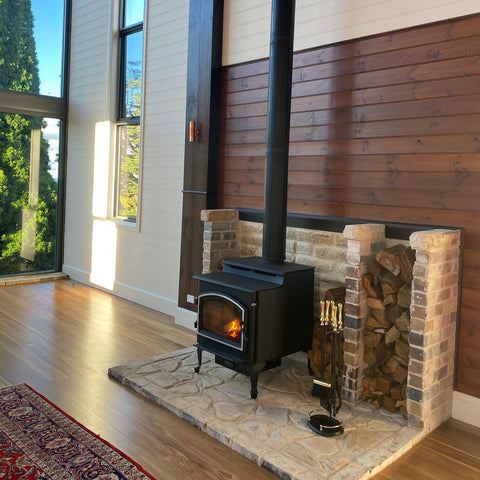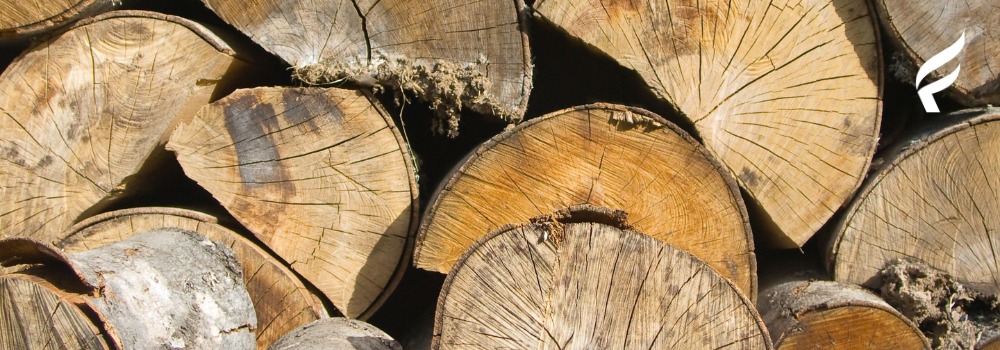So you’ve decided that you’re going to heat your home with cozy and cost-effective wood fire heating from now on. You’ve got your Quadra-Fire or Vermont Castings stove installed, the temperature is dropping, and you’re ready to curl up with a good book by the fire. You want to be prepared for anything that Old Man Winter brings, so you need to determine how much wood you will need. We’re here to help!
Keep reading to learn the best way to secure, stock and store your wood supply.
What is a Cord of Wood?
A cord of wood is a measurement that dates back to the 17th century. It describes a firewood stack that contains 128 cubic feet of firewood. Typically, a cord is stacked 4 feet high, 8 feet wide, and 4 feet deep. This configuration can make for a gorgeous firewood stack!
But not all firewood is created equally. There’s no easy answer to the question, “how long does a cord of wood last?” Accurately calculating cords of wood needed to heat your home for a given period of time requires accounting for several variables, including species, whether it is seasoned firewood, stove efficiency, and the amount of space needing to be heated. When computing the amount of wood, be aware that you may come up with a number that includes a half cord. Most firewood suppliers will be happy to accommodate your need for partial cords.
How Much Heat Does Firewood Produce?

When calculating your firewood volume needs, it’s vital to use standardized metrics where possible. One such metric is the BTU, or British Thermal Unit, which indicates how much heat energy a fire produces.
Maximizing BTU output relies on using the appropriate species of seasoned firewood. Seasoned firewood typically puts out more BTUs, while unseasoned firewood can create a weak flame with a low BTU output. Check out this blog to learn more about how to season firewood and other wood characteristics. Keep in mind that the species of wood that you’re burning has a significant effect on heat output, in addition to several other things like aroma and smoke production. For example, a well-seasoned white oak log will produce upwards of 25 BTUs, while a fire utilizing cedar firewood will produce less than 15 BTUs.
How to Determine How Much Wood You Will Need This Winter
Now we come to the ultimate question: how much firewood do I need? Using these guidelines, you will be able to accurately determine how much wood you’ll require to meet your heating needs this winter.
Home Variables
The geographical location, thus the climate of your home, is the most important factor in calculating your firewood demand. Another significant variable is your intended usage. Will you be having fires all day, or only at night? The layout of your home also factors into the calculation.
Zone Heating
Zone heating describes heating only a portion of your home, which is an ideal strategy to know how much wood you need this winter. Allowing specific heat zones benefits in multi-level homes, large properties or houses with areas that are rarely used. Targeting specific areas significantly reduces energy waste. Not only does this contribute to a sustainable household, but it also saves you money. By utilizing zone heating, you’re using less fuel to heat less space which cuts annual heating expenses by up to 30%. Additionally, zone heating offers personal comfort, letting you concentrate the heat in your most lived-in areas.
Unit Efficiency
Every stove that we offer is EPA-certified and designed for efficiency. Not only are fires in a Quadra-Fire or Vermont Castings stove better for the environment compared to older, less efficient stoves, but they’re better for your wallet. With efficiency ratings up to 80% our stoves ensure that you are getting the most warmth from your firewood so you can worry about enjoying the fire, not managing your firewood stack.
Type of Wood
It bears repeating that the type of wood and its condition are paramount in maximizing the efficiency of your stove. To put it simply, you’ll have the best experience with a hardwood that’s been seasoned for an appropriate amount of time. Well-seasoned, dry wood will burn best and minimize unwanted byproducts such as creosote buildup and excessive smoke. Look around your area, and you’ll be sure to find a firewood supplier who can provide you with a local species that has been seasoned properly and is ready to burn.
Rough Calculation
For cold climates like the Northeast and Midwestern states, plan on 2-3 cords of firewood per 1,000 square feet of space you’re heating. In milder climates such as Mid-Atlantic and Southern states, 1-2 cords per 1,000 feet should be plenty to keep you warm. It’s always best to be over-prepared when it comes to the safety and comfort of your family. Don’t hesitate to round up when you are making your calculations, and keep track of how much wood you’re utilizing every year.
Where to Purchase Firewood
There are likely a handful of suppliers in your area who will be happy to sell you the cords of firewood that you need. A quick internet search should yield a number of options ranging from private sellers to arborists looking to offload excess wood. The typical price for a cord of softwood will cost between $200 and $300, while a cord of hardwood will run you between $300 and $400.
Late spring or early summer are the best times to buy firewood, as the demand for firewood is lower. Wood is more readily available, thanks to the more felling of trees.
How to Store Wood for the Winter
Firewood storage doesn’t have to be hard. All you need is a flat, dry space and a way to keep the wood off of the ground. If you have the resources to build a firewood shed you can further protect your investment. Properly stored firewood can last up to ten years, but we recommend a maximum of 2 to 3 years. If you avoid moisture and restricting airflow through your stack, your firewood will only improve with age.
To get the best results you’ll need to stack the wood immediately to avoid any moisture uptake from having the firewood strewn on the ground. Start your stack with two to three pieces of wood placed parallel on the platform that you’re using to keep the stack off of the ground. Then place the next row perpendicular to the first row, and repeat the pattern. If you’d like to learn more stacking techniques read our guide to stacking firewood.
You can use one of these techniques to give yourself an indoor stack near the stove that’s visually attractive and handy, as keeping some firewood inside will keep you from needing to brave the chilly outdoors when it’s time to put another log on the fire.
Next Steps

Now that you’re equipped to determine how much wood you’ll need this winter, check out Forge & Flame’s array of wood inserts and stoves to keep you cozy and warm. Whether you opt for a state-of-the-art Quadra-Fire stove or an elegant Vermont Castings option, you’ll love the warmth and ambiance that a wood stove brings to your home.


